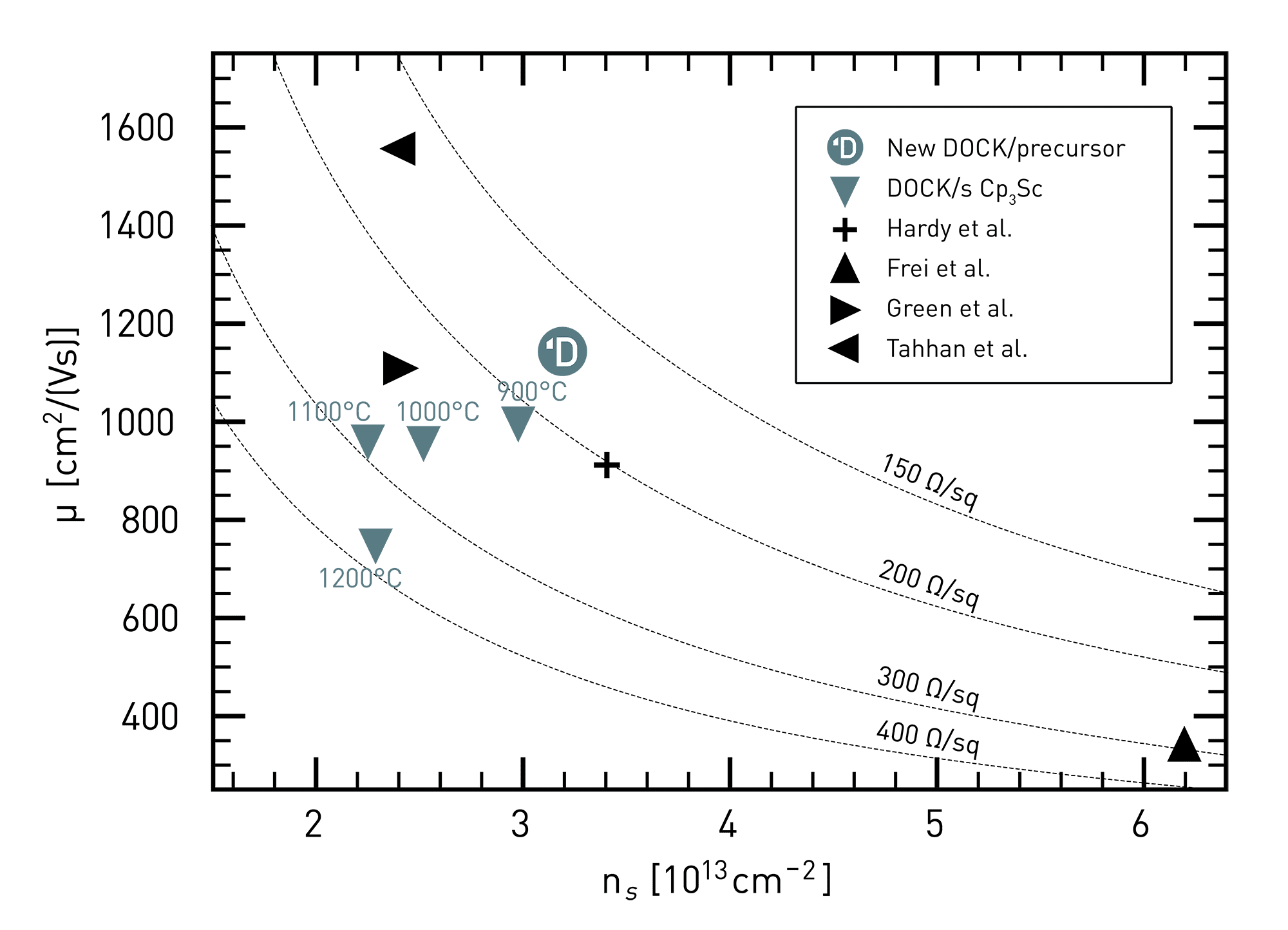(Al,Sc)N as Barrier Material for HEMTs
The growing data volume processed per day in our increasingly digitalized society demands alternatives to the limited silicon technology. High-frequency devices play a crucial role in handling the vast data volume in today’s data and satellite communication as well as for autonomous driving. Additionally, to tackle the energy transition efficient high-power devices are essential for the conversion of electricity in electric vehicles or solar power plants. Nitride-based High-Electron-Mobility-Transistors (HEMTs) are suited for high-power and high-frequency devices because of their capability to handle high voltages, their high carrier density, and switching frequencies. Devices employing (Al,Ga)N barrier layers are already commercially available, nevertheless, (Al,Sc)N may outperform (Al,Ga)N-based devices. The increased piezoelectric coefficient and spontaneous polarization enhance the sheet carrier density of (Al,Sc)N HEMTs by up to a factor of five!
Epitaxial Challenges
A low defect density, sharp interfaces, and precise control of the layer thickness are crucial for the application of (Al,Sc)N in electric and optoelectronic devices. Sputtering processes and hydride vapor phase epitaxy allow the deposition of (Al,Sc)N, however, they do not meet all of the aforementioned criteria. On the other hand, molecular beam epitaxy enables high-quality layers suitable for HEMTs but the limited efficiency of the technique requests alternatives.
Metalorganic Vapor-Phase Deposition (MOCVD) meets all the criteria and is economically viable, but the challenge is to find the right precursor for Sc. The precursors must be free of oxygen to keep oxygen incorporation low; the synthetic route may not be too complex, and most importantly must have a high enough vapor pressure to allow significant incorporation of Sc, ideally while being in liquid state.
MOCVD of (Al,Sc)N HEMT Structures
The first demonstration of significant Sc incorporation into AlN has been published by Stefano Leone from the Fraunhofer Institute for Applied Solid State Physics IAF in 20191. The key to success has been the customization of the MOCVD showerhead reactor and gas injection system for heating the precursor line up to 150 °C, allowing the deposition of (Al,Sc)N layers with up to 30 %Sc using Tris(cyclopentadienyl)scandium (Cp3Sc) as precursor. In further studies, the influence of process parameters, such as reactor pressure, temperature as well as flow modulated growth and different cap layer material have been investigated in terms of impurity incorporation, surface morphology, and element diffusion between different layers2,3. Increasing the growth temperature leads to low impurity incorporation and enhanced morphology, however, the diffusion of atoms between different layers limits the device performance. To decrease the thermal budget alternative precursors with enhanced vapor pressure are required to enhance the growth rate and reduce the thermal budget.

In the joint BMBF project PuSH the new DOCK precursor Bis(methylcyclopentadienyl)scandium chloride (MCp2)ScCl precursor has been synthesized by Dockweiler Chemicals and employed by IAF for deposition of (Al,Sc)N. The precursor shows an enhanced vapor pressure and a melting point at 155 °C. In a recent study, it has been possible to double the growth rate of (Al,Sc)N by using (MCp)2ScCl instead of Cp3Sc resulting in a reduced thermal budget4. Moreover, smooth surfaces have been observed even at lower temperatures, which has not been possible with Cp3Sc. Secondary ion mass spectrometry showed that no Cl incorporation is observed above the detection limit. With a sheet resistance of Rsh = 172 Ω/sq, electron mobility µ = 1124 cm²/(Vs), and a sheet carrier density ns = 3,23*1013 cm-2, the electrical characteristics of a HEMT device are among the best reported so far.
Dockweiler Chemicals is encouraged to further improve the device performance by enhancing the vapor pressure of the Sc precursor (by varying the ligands towards N-containing alternatives) and optimizing the purification of the material.

References:
- Leone, S. et al. Metal‐Organic Chemical Vapor Deposition of Aluminum Scandium Nitride. physica status solidi (RRL) – Rapid Research Letters 14, 1900535 (2020) doi: 10.1002/pssr.201900535.
- Manz, C. et al. Improved AlScN/GaN heterostructures grown by metal-organic chemical vapor deposition. Semicond Sci Technol 36, 034003 (2021) doi: 10.1088/1361-6641/abd924.
- Ligl, J. et al. Metalorganic chemical vapor phase deposition of AlScN/GaN heterostructures. J Appl Phys 127, 195704 (2020) doi: 10.1063/5.0003095.
- Streicher, I. et al. Enhanced AlScN/GaN Heterostructures Grown with a Novel Precursor by Metal–Organic Chemical Vapor Deposition. physica status solidi (RRL) – Rapid Research Letters 2200387 (2022) doi: 10.1002/pssr.202200387.